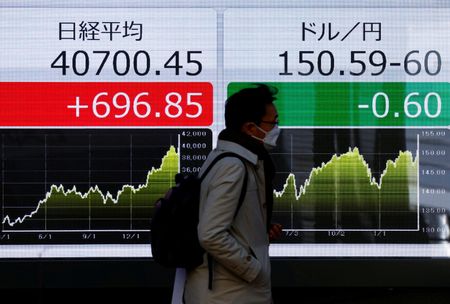By Jamie McGeever
(Reuters) – A look at the day ahead in Asian markets.
Asian markets are set to open on the defensive on Monday, with heightened tensions in the Middle East spurring strong demand for safe-haven assets like the dollar, gold and U.S. Treasuries at the expense of stocks and local currencies.
Investor sentiment was already veering towards the negative following the U.S. bank earnings-driven equity market slump on Friday – JP Morgan shares had their biggest fall in almost four years and world stocks lost the most in six months.
U.S. stock futures are pointing to another steep decline at the open on Monday, so it’s likely Asian bourses will follow suit. Oil prices, which hit a six-month high on Friday, are likely to make further gains on Monday.
In such a febrile environment local Asian economic indicators and events are likely to take a back seat. Monday’s calendar is pretty light, with only Indian trade and wholesale price inflation data, and Japanese machinery orders on tap.
China’s first-quarter GDP on Tuesday and Japanese consumer price inflation figures on Friday are the two economic indicators from Asia that could most move local markets this week.
But for Monday at least, investors will be focused on reducing risk and playing it safe, and in that regard, there could be some big movement in the Japanese yen.
The yen is traditionally seen as a ‘safe-haven’ asset that does well in times of heightened risk aversion, boosted by large repatriation flows from Japanese investors and short covering from currency traders using the yen to fund carry trades.
And there is a large short position to cover – the yen is at a 34-year low below 153.00 per dollar and the latest U.S. futures market data show hedge funds’ net short yen position is the biggest in 17 years.
To the surprise of many, Japanese authorities have not yet intervened to stop the rot, despite the near-daily warnings from officials that “excessive volatility is undesirable” and that Tokyo stands ready to respond to sharp currency swings.
Perhaps Tokyo has not yet intervened because the yen’s slide is fully justified on “fundamental” grounds – U.S. yields and implied rates are rising faster than their Japanese equivalents because U.S. growth and inflation rates are higher than Japan’s.
The strong dollar and recent spike up in U.S. bond yields, however, pose potentially significant problems for Asia. They represent a tightening of financial conditions and make servicing dollar-denominated debt more expensive.
A sharp fall in Treasury yields as investors scramble to reduce risk in their portfolios due to intensifying geopolitical tensions is unlikely to offer much comfort.
Here are key developments that could provide more direction to markets on Monday:
– India trade (March)
– India wholesale price inflation (March)
– Japan machinery orders (February)
(By Jamie McGeever; editing by Diane Craft)





